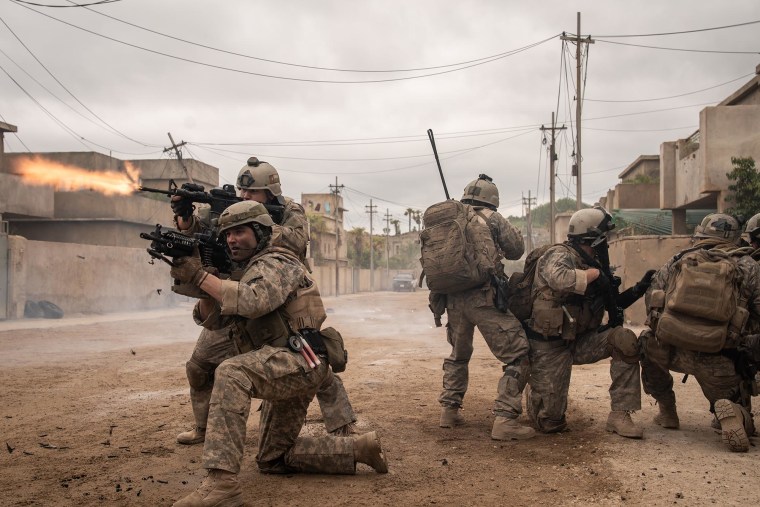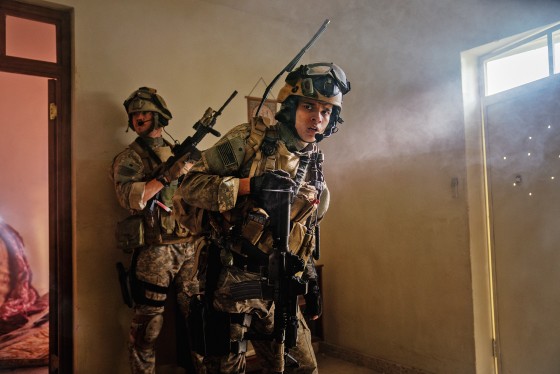The central value proposition of “Warfare,” the new Iraq War film co-written and co-directed by ex-Navy SEAL Ray Mendoza and Alex Garland, is realism. On a technical level, it hits the mark. As a story about the U.S. war in Iraq, it obscures and sanitizes the conflict it seeks to depict.
“Warfare” is based on a real mission that Mendoza himself participated in, and is constructed from his memories and those of other participants. In a taut 95 minutes, Mendoza and Garland aim to re-create how a Navy SEAL team conducting a sniper overwatch mission in Iraq in 2006 was discovered and attacked by insurgent fighters, and the SEAL team’s subsequent struggle to make it out alive.
In ‘Warfare,’ Iraqi civilians are given scarce screen time and mostly ignored.
Mendoza has described his approach to the story as “investigative, forensic” and said the threshold for including material was “if it didn’t happen on that day, it wasn’t going to be in the film.” A lot of the movie depicts moments of life in combat with a naturalism that is rarely seen on the silver screen. As the SEAL platoon breaks into an Iraqi civilian home and turns it into a makeshift surveillance center, the viewer is immersed in constant, detailed communications about location and the tedious minutiae of intelligence sharing that may or may not be significant. We witness the enervating focus required to monitor city streets with a sniper scope for hours, and mundane banter as a SEAL complains about having lost a shirt. There is a sense of being embedded in there alongside the SEAL team in real time, and the buzz around the movie is about how “scrupulously realistic” it is.
But this movie is not a documentary, nor is it shot like one.
This movie is driven by spectacle — specifically, awesome displays of American power and precision. The training and movement of the SEALS, the sophisticated weapons at their command, the way aircraft are deployed in “show of force” maneuvers to deter insurgents are central to the entertainment. The film’s sometimes-deafening soundscape is a distinct character unto itself, and is designed to immerse the audience in an atmosphere of omnipresent threats and the U.S. military’s earth-shattering strength.

“Warfare” is also a horror film. When the humdrum nature of the surveillance mission is interrupted by the SEALs’ growing anxiety that they’ve been “peeped” by insurgents, the movie shifts gears. The professional commands are quickly overlaid with nervousness, and the film exhibits the camerawork, suspenseful pacing, focus on bodies and shocking scares of a horror film. These are deftly handled, exhibiting the seasoned hand of Garland, who has made dark, kinetic thrillers like “28 Days Later” and “Ex Machina.”
In other words, “Warfare” is not just about what happened to that SEAL platoon that day, but how they felt: the isolation, the fear, the terror. Mendoza has described the making of the film as “therapeutic,” as veterans are rarely afforded the opportunity to discuss “the emotional components” of what they endure. The end of the film thanks members of the team for “always answering the call” and shows many of their real-life counterparts.
The focus in “Warfare” on the thrill of superior firepower and the framing of U.S. service members as the primary victims of the Iraq War ultimately means we are not in groundbreaking territory. The two buzziest and most influential American films about the conflict, “The Hurt Locker” and “American Sniper,” are analogous films in these respects. “The Hurt Locker” is about the exceptionally skilled and daring leader of a bomb technician squad who becomes consumed by the fight and struggles to adapt to civilian life. “American Sniper” is about a gifted and self-effacing sniper who is traumatized by the war and also struggles to return to civilian life.
The U.S. service members who were traumatized, hurt or killed after being sent into a dishonorable war that was waged based on lies deserve our sympathy and support. But let’s see the forest for the trees. All three films commit the same perverse inversion of moral common sense. They depict the U.S. invasion and occupation as a precise, restrained operation run by near-perfect warriors with a high regard for civilian life, when it was not. Civilians were tortured and hundreds of thousands were killed through brutal cluster munitions, lax rules of engagement, trigger-happy defense contractors, poor intelligence during massive airstrikes and an occupation-induced collapse of Iraqi society and economy.
And even as these movies invite sympathy and admiration for American troops, they treat most or all Iraqis as faceless, spooky villains or two-dimensional props. In “Warfare,” Iraqi civilians are given scarce screen time and mostly ignored, and the Iraqi soldiers who work with the Americans are depicted as reluctant fighters and cowards. The insurgency is purely menacing.

Imagine, for example, watching a movie about Russian soldiers embedded in a hostile Ukrainian town that focuses on the perspective and plight of the Russian invaders and depicts the Ukrainians as monsters and bystanders. Now imagine watching one movie after another about it. That’s how Hollywood almost invariably seems to approach the Iraq War. “Warfare” may be a mostly accurate account within the aperture of the lens that it applies to the war. But its action sequences don’t change the true horror story of what happened — a war of aggression based on a false pretext that killed hundreds of thousands of Iraqis and ruined the lives of millions more.
The choice to name the film “Warfare” underscores the conceit that this movie seeks to capture something essential about warfare with its extraordinary attention to detail. It is also apropos that a movie with such a title narrows the audience’s moral universe while mesmerizing the audience with a spectacular display of force. If we want to overcome this sickness, we ought to think more about who is being shot at, and why.

